Multiple Choice
Identify the
choice that best completes the statement or answers the question.
|
|
|
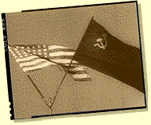 Once allies against
Hitler, the Soviet Union and the United States confront each other at the end of World War II.
Looming over the postwar landscape is the awesome, mushroom-shaped cloud of the atomic
bomb. Once allies against
Hitler, the Soviet Union and the United States confront each other at the end of World War II.
Looming over the postwar landscape is the awesome, mushroom-shaped cloud of the atomic
bomb.
|
|
|
1.
|
What is the awesome,
mushroom-shaped cloud?
a. | The
Kremlin | c. | The hydrogen bombs
under development | b. | The atomic bombs dropped by the U.S. | d. | Poison gas being developed by
Russia |
|
|
|
2.
|
The Soviet Union was an ally of
Germany at the start of World War II. How and why did it become an ally of the U.S. during the
war?
a. | Germany attacked the Soviet
Union | c. | The Soviet’s thought Germany
might loose the war | b. | The Soviet Union changed its mind because it wanted U.S.
loans | d. | Germany attacked
France |
|
|
|
REVOLUTION
The seeds for the Cold War are planted during World War I and the ensuing revolution in
Russia. In 1917, the new communist government led by Vladimir Lenin withdraws Russia from the war --
and signs a separate peace with Germany. Many of the Western Allies view the new Russian government
with suspicion.
Russia's treaty with Germany ends fighting on the Eastern Front. But from
1918 to 1920, civil war rages in Russia -- with the anti-communist forces receiving support from the
West and elsewhere as part of an unsuccessful attempt to oust the Bolsheviks.
Following
Lenin's death in 1924, Joseph Stalin rapidly rises to power. By the 1930s, Stalin's
"Great Purge" is under way. Millions are arrested, and many are executed or sent to prison
camps, as Stalin tightens his grip on the nation.
|
|
|
3.
|
In 1917 Russia was ruled by
Czar Nicholas (the king). In October of that year there was a revolution. Who replaced the Czar and
later had the Czar and his family shot?
a. | the
Allies | c. | the
Communists | b. | the Germans | d. | the Nazi’s |
|
|
|
4.
|
Who was the first leader of the
Communist government in Russia?
a. | Trotsky | c. | Stalin | b. | Lenin | d. | Czar Nicholas |
|
|
|
5.
|
Why did the Western Allies view the new Russian government with
suspicion?
a. | The Communists pulled Russia out of
the war leaving England, France and the U.S. to fight Germany alone. | c. | The Russians teamed-up with the Germans to fight the
Allies | b. | The Russians said they were not going to pay their war debts to the
U.S. | d. | Germany and Russia invaded
Poland |
|
|
|
6.
|
What is a Bolshevik?
a. | a
Loyalist | c. | a
German | b. | a Communist | d. | a Fascist |
|
|
|
7.
|
Germany was fighting a two
front war. England, France and the U.S. were fighting Germany on the _____ front, while Russia was
fighting on the _____ front.
a. | Southern
-Western | c. | Eastern -
Western | b. | Northern - Southern | d. | Western -Eastern |
|
|
|
8.
|
The Russian revolution took
place in 1917. The person who led the revolution died in 1924. Who was that
person?
a. | Stalin | c. | Lenin | b. | the Czar | d. | Trotsky |
|
|
|
9.
|
What is it called when an evil
leader gets rid of his enemies through killing and imprisonment?
a. | riot | c. | war | b. | purge | d. | court martial |
|
|
|
10.
|
During the 1930’s, Stalin
became a _____ of Russia?
a. | President | c. | Servant | b. | Dictator | d. | Citizen Czar |
|
|
|
11.
|
Sometimes the U.S., and England
are referred to as the
a. | North | c. | South | b. | East | d. | West |
|
|
|
12.
|
Sometimes the Soviet Union
(Russia) is referred to as the
a. | North | c. | South | b. | East | d. | West |
|
|
|
13.
|
When it is said that the seeds
of the Cold War were planted in 1917, what do they mean?
a. | Communism began in
1917 | c. | The beginning of the cold war
started with the Versailles Treaty | b. | Suspicion between Communist Russia and the allies started by events that took
place 1917 | d. | The beginning of the cold war
started with the non-aggression pact between Germany and
Russia |
|
|
|
14.
|
Why did many Americans feel
betrayed by Castro?
a. | He did not announce to the Americans
that he was a Communist until after he took power. | c. | He owned a great deal of land and industry in
Cuba | b. | He was a supporter of Bautista, the dictator of
Cuba | d. | He announced to the Americans that he was a Communist
before he took power but Americans did not believe him. |
|
|
|
15.
|
Who were tried and executed by
the Castro Communists in the Havana Sports Arena?
a. | People thought to be pro-Bautista
and anti-Castro | c. | People thought to
be anti-Castro Communists. | b. | Cuban Communists | d. | Cuban revolutionaries |
|
|
|
16.
|
Why did many Americans go to
Cuba in the 1940’s and 1950’s?
a. | It was a Communist resort
island | c. | The Castro government welcomed
Americans | b. | Castro was the Robin Hood of Cuba and Americans liked Robin
Hood | d. | It was a vacation resort with many hotels, casinos, and
beaches |
|
|
|
17.
|
Why did many Americans call
Fidel Castro the Robin Hood of Cuba?
a. | He was a
communist. | c. | He was thought to
be a hero fighting for the people against a dictator. | b. | Robin Hood and Castro were both
communists | d. | He took from the poor and gave to
the rich |
|
|
|
18.
|
 This person led the
Russian revolution. He is sometimes called the father of modern Communism. Who is
he? This person led the
Russian revolution. He is sometimes called the father of modern Communism. Who is
he?a. | Trotsky | c. | Lenin | b. | Stalin | d. | Czar Nicholas |
|
|
|
19.
|
 This man is one of
the most vicious men who has ever lived. He was dictator of Russia for 29 years and killed millions.
Who is he? This man is one of
the most vicious men who has ever lived. He was dictator of Russia for 29 years and killed millions.
Who is he?a. | Stalin | c. | Czar Nicholas | b. | Lenin | d. | Trotsky |
|
|
|
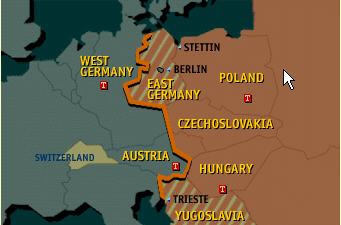 | In the months following their victory in World War II, the alliance between
the Soviet Union and the West quickly proves to be little more than a marriage of convenience.
Suspicion clouds relations -- while a curtain descends over Europe. Concerned about the expansion
of a Communist dictatorship across much of Europe, Winston Churchill first used the term, “Iron
Curtain”, in a speech in President Truman’s home town in Missouri. People listened to
Churchill because he was one of the first to warn the world about Adolf Hitler and Nazi
Germany
| | |
|
|
|
20.
|
Who imposed an “Iron
Curtain” across Europe
a. | Germany | c. | The Allies | b. | Poland | d. | The Soviet Union |
|
|
|
21.
|
What was the “marriage of
convenience” between the Soviet Union and the West?
a. | Working together to defeat Germany
in WWII | c. | Working together
to defeat Germany in the Cold War | b. | Working together to defeat Germany in WWI | d. | Working together to enforce the Treaty of
Versailles |
|
|
|
22.
|
 What country was
Winston Churchill from? What country was
Winston Churchill from?a. | Missouri | c. | France | b. | The U.S. | d. | Great Britain |
|
|
|
23.
|
What was the iron
curtain?
a. | A steel and barbed wire fence
between Germany and the Soviet Union | c. | A division of Europe between the Communist countries in the East and the free
countries in the West. | b. | A political division between Eastern Europe and
Russia | d. | A division of Europe between the Communist countries in
the West and the free countries in the East |
|
|
|
24.
|
After the Iron Curtain was
imposed in Europe, which country found itself living under a Communist
dictatorship?
a. | West
Germany | c. | Austria | b. | East Germany | d. | None of these |
|
|
|
HOMECOMINGS
The United States
emerges from World War II with both its government and economy intact. In fact, the American war
machine has revitalized the nation's businesses and brought affluence to more people on levels
unimaginable during the pre-war Depression. Many Americans have more money to spend because people
worked long hours in defense plants during the war and there was nothing to spend money on. No new
homes were built, no new cars were manufactured and there was rationing on most consumer
goods.
England is a small country and suffered from German bombing. France surrendered to Germany
early in the war and suffered little, except for some towns and villages after the D Day invasion.
The nations that suffered most were Germany and the Soviet Union. Millions died in both countries and
their nations infrastructure was in ruins. The infrastructure of a nation includes such things as
railroads, bridges, mines, factories, and roads.
|
|
|
25.
|
After WWII most Americans found
themselves
a. | better off
financially | c. | about the same
financially as they were before the war | b. | worse off financially | d. | with a great deal of debt because of credit
purchases |
|
|
|
26.
|
Why was the American
infrastructure left unharmed after WWII?
a. | Americans had
rationing | c. | The continental
U.S. was never bombed or attacked | b. | American factories were manufacturing war
goods | d. | America was a Capitalist
country |
|
|
|
27.
|
When was the Great
Depression?
a. | post World War
II | c. | during World War
II | b. | pre World War
II | d. | during the Cold
War |
|
|
|
28.
|
Which countries suffered most
during World WarII?
a. | U.S. and Great
Britain | c. | Germany and
Russia | b. | France | d. | France and
Germany |
|
|
|
CONQUERED,
DIVIDED
Germany, which had
terrorized and occupied much of the European continent, now finds itself divided among the victors.
Four occupation zones are established, and each of the Allies sets up a sector in Berlin.
Meanwhile, national borders are being redrawn in an attempt to settle old scores. Millions of
ethnic Germans are expelled from Poland, Czechoslovakia and Hungary.
|
|
|
29.
|
Which country is divided into
four zones after World War II?
a. | France | c. | Soviet Union | b. | Russia | d. | Germany |
|
|
|
30.
|
Which German city was divided
into four zones after WWII?
a. | Hamburg | c. | Belgrade | b. | Berlin | d. | Stalingrad |
|
|
|
SOVIET
CONTROL
New power struggles spring up in many European
countries following World War II, as communist and capitalist factions vie for control. The most
notable and brutal example of these is the drawn-out civil war in Greece.
Many Americans are concerned because it seemed that the
Soviet Union was extending its control over all of Eastern Europe. The Soviets were taking advantage
of the political and social upheaval, brought about by World War II, to agitate for Communist
revolutions throughout the world. World Communism was a continuation of the policy that the Soviet
Union had before World War II.
|
|
|
31.
|
Why were Americans concerned
with the events in Europe after World War II?
a. | Communist Russia was seizing control
in many European Countries and setting up dictatorships | c. | The Soviets were threatening to revive the Nazi’s in
Germany | b. | The Soviet Union was setting up democratic governments in many places in
Europe | d. | France refused to support us in the United
Nations |
|
|
|
32.
|
What kind of government did the
Soviet Union have?
a. | Democracy | c. | Totalitarian Dictatorship | b. | Democratic Socialist | d. | Democratic Communist |
|
|
|
33.
|
Political and social conflict
can often lead to ______ . This is was happened in Germany after World War I and what happened in
many places throughout the world after World War II.
a. | democracy | c. | freedom | b. | totalitarianism | d. | stability |
|
|
|
WARNINGS
Comments by Stalin in early 1946, that capitalism and imperialism made future
wars inevitable, set off alarm bells in the West. George Kennan, a career U.S. diplomat in Moscow,
was asked by the State Department for his view on Soviet motives and intentions. His famous cabled
response warned there could be no permanent, peaceful coexistence with the Soviet Union.
Days
after Kennan's telegram, Winston Churchill, the former British prime minister, arrives in the
United States. He later speaks at a college in Fulton, Missouri, the home state of his host, U.S.
President Harry Truman. It coined the phrase that best described the political and ideological divide
between the Soviets and the West as the Cold War began.
|
|
|
34.
|
Who said that because of
capitalism and imperialism, future war with the Soviet Union is inevitable?
a. | Joseph Stalin, leader of Great
Britain | c. | Joseph Stalin,
leader of Soviet Russia | b. | George Kennan | d. | Winston Churchill |
|
|
|
35.
|
The comments by Joseph Stalin
in 1946 showed that
a. | he wanted peaceful
coexistence | c. | he saw the U.S. as
an enemy | b. | he wanted war with the U.S. as soon as
possible. | d. | he wanted friendship with the
U.S. |
|
|
|
36.
|
What is the phrase that best
described the political and ideological divide between the Soviets and the West and signaled the
start of the Cold War.
a. | Steel
Curtain | c. | Partition of
Germany | b. | Iron Curtain | d. | Berlin Wall |
|
|
|
37.
|
Moscow is the capital of what
country?
a. | Poland | c. | East Germany | b. | Germany | d. | Soviet Union |
|
|
|
TRUMAN'S
DOCTRINE
Churchill's "Iron Curtain" speech
set the tenor for the growing tensions between the Soviet Union and its former allies.
The chill
in relations between communism and the West coincides with the unusually bitter winter of 1946-47. As
shortages and famine gripped an exhausted Europe, President Truman announced what became known as the
Truman Doctrine.
The Truman Doctrine was first established in 1947 after Britain no longer could
afford to provide anti-communist aid to Greece and Turkey, it pledged to provide U.S. military and
economic aid to any nation threatened by communism.
|
|
|
38.
|
Shortages, famine and the cold
winter benefited
a. | the U.S. who wanted to keep the
European countries suppressed and under control | c. | the Soviet Union who wanted to foment communist revolutions in
Europe | b. | the British who wanted to maintain control of its European
colonies | d. | Germany who was evolving as a new
economic super-power in Europe |
|
|
|
39.
|
From this passage, we can infer
that
a. | Truman respected
Churchill | c. | Truman feared
Churchill | b. | Churchill feared Truman | d. | Truman and Churchill were suspicious of each
other. |
|
|
|
40.
|
From this passage we can infer
that
a. | The U.S., Britain, and Greece were
allies | c. | The U.S. and Britain were
allies | b. | The U.S. Britain and Turkey were allies | d. | The U.S., Britain, and Russia were
allies |
|
|
|
41.
|
Why did Great Britain give up
its traditional role as leader of the continent of Europe?
a. | It was devastated and financially
ruined from World War II | c. | It no longer
considered itself a European country | b. | It did not want to challenge the United
States | d. | It was on the verge of war with
Ireland |
|
|
|
42.
|
London is the political capital
of what country?
a. | France | c. | Great Britain | b. | Russia | d. | Germany |
|
|
|
43.
|
Why was the President Truman so
concerned about Greece and Turkey. Why did he feel he needed to give them aid?
a. | They were allies of the U.S. in both
world wars. | c. | Truman wanted to
build them up so the U.S. could trade with them. | b. | Truman’s family was
Turkish | d. | Truman was afraid they might turn
Communist. |
|
|
|
44.
|
What did Truman do that made
the differences between Soviet totalitarianism and the Western democracies
clear?
a. | Sent aid to Turkey and
France | c. | Established the Truman
Doctrine | b. | Sent aid to Greece and Turkey | d. | Held the Yalta Conference |
|
|
|
The Marshall Plan 1947 -
1952
With hunger and discontent
plaguing postwar Europe, the U.S. proposes an aid program to rebuild the ruined continent.
But
the Marshall Plan also solidifies the deep ideological differences between East and
West
POSTWAR
EUROPE
| The events that brought about the Marshall Plan were spurred on by a
combination of man-made and natural disasters. Immediately following World War II, much of Europe was
in chaos.
Millions of refugees roam the continent, some attempting to return home after the war,
others fleeing westward, away from Soviet domination. Governments lie toppled, national economies
remain in ruin. | | |
Meanwhile, the harvest
of 1946 is poor, and the winter of '46-47 is one of the worst in memory. The strife leads many
in Western Europe to consider communism as an end to the hard life and injustices they
suffer.
|
|
|
45.
|
What was the purpose of the
Marshall Plan?
a. | Help Europe get back on its feet and
prevent mass starvation | c. | Help prevent
starvation in the Soviet Union | b. | Equip an army to confront the Russians | d. | Help to rebuild Eastern Europe and prevent
starvation |
|
|
|
46.
|
How did World War II leave
Europe?
a. | revitalized | c. | wealthy | b. | inspired | d. | devastated |
|
|
|
47.
|
The passage suggests that there
was a danger that an economically devistatedd Europe with a starving population
might
a. | turn to
Capitalism | c. | turn to Hitler
again | b. | turn to Communism | d. | become challenge U.S. economic
power |
|
|
|
48.
|
Who were the refugees trying to
escape from in Europe?
a. | The
Nazi’s | c. | The
Russians | b. | The Americans | d. | Great Britain |
|
|
|
49.
|
Who suffered most in Europe
after World War II?
a. | The Soviet
Military | c. | The civilian
population | b. | The British and Americans | d. | The Communist Party members |
|
|
|
50.
|
What does the phrase,
“But the Marshall Plan also solidifies the deep ideological differences between East and
West,” suggest?
a. | The Marshall Plan will help to bring
Russia and the U.S. closer | c. | The Marshall Plan will help solidify the divisions between the Soviet West and
the American East. | b. | The Marshall Plan will make the situation between the Communist countries and
the West worse than it already is. | d. | The Marshall Plan will make Communism
stronger. |
|
|
|
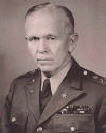
George Marshall | GEORGE MARSHALL
Truman turns
to his secretary of state, George Marshall, to put Europe back on its feet economically. Marshall had been famous for his
logistical skills while U.S. Army chief of staff during the war. (logistical skill means the ability
to get supplies for the troops)
Marshall meets with others from the so-called "Big
Four" in Moscow, in an attempt to determine the future of then-occupied Germany. But the talks
go nowhere. The Big Four were the U.S., England, France and the Soviet
Union | | |
|
|
|
51.
|
Why did Truman pick Marshall to
help feed the people of Europe?
a. | He had experience at supplying the
troops in World War II | c. | He was a farmer in
civilian life | b. | He was a Democrat | d. | He was a Republican |
|
|
|
52.
|
The “Big Four” was
another name for the allies in World War II. Which country below was not one of the allies
a. | United
States | d. | Germany | b. | Great Britain | e. | Soviet Union | c. | France |
|
|
|
53.
|
From the passage, how can you
tell that George Marshall tried to “reach out” to the Soviet Union?
a. | He went to Moscow for
talks | c. | He was an
anti-capitalist | b. | He offered aid to Turkey and Greece | d. | He was an anti-communist |
|
|
|
THE PLAN
 | Marshall formally announces what will become known as the
European Recovery Program
during a ceremony at Harvard University. The Marshall Plan offers billions of dollars in U.S. aid
to European countries -- including those under Soviet occupation.
Soviet spies in London keep
Moscow up to date on the Marshall Plan, which the Kremlin views with growing suspicion. Stalin orders
his foreign minister, Vyacheslav Molotov, to pull out of a Paris conference designed to frame
Europe's response to the Marshall Plan | | |
Marshall formally announces what will become known as the European Recovery
Program during a ceremony at Harvard University. The Marshall Plan offers billions of dollars in U.S.
aid to European countries -- including those under Soviet occupation.
Soviet spies in London keep
Moscow up to date on the Marshall Plan, which the Kremlin views with growing suspicion. Stalin orders
his foreign minister, Vyacheslav Molotov, to pull out of a Paris conference designed to frame
Europe's response to the Marshall Plan.
As Molotov leaves Paris, he accuses the West of
working to divide Europe into two hostile camps. In fact, Czechoslovakia considers attending the
Paris conference on the Marshall Plan -- only to be told in no uncertain terms that Moscow is against
it.
|
|
|
54.
|
Which statement below is true
about the Marshall Plan?
a. | If offered aid to Western, but not
Eastern, Europe | c. | It was a
conspiracy buy the big oil companies in the U.S. to control Iraq
oil | b. | If offered aid to Western and Eastern Europe | d. | If offered food but not economic
aid |
|
|
|
55.
|
From the reading passage, how
can you tell that the Soviets had established a dictatorship over Easter Europe?
a. | The Soviets spied on the
U.S. | c. | The soviets would not talk to the
Eastern European countries | b. | The Soviets were cruel to Germany | d. | The Soviets ordered Czechoslovakia not to attend the Marshall Plan
Conference |
|
|
|
56.
|
How did the Soviets react to
the Marshall Plan?
a. | They wanted it to
succeed | c. | They were
suspicious of it and thought it would make Europeans feel they owed something to the
U.S. | b. | They preferred to work through the U.N. | d. | They liked the plan but did not like
Marshall |
|
|
|
Communist COUP
(A coup is the overthrow of a
government.)
In September 1947, as
the Marshall Plan gets under way, the Soviets set up the Cominform, the Communist Information Bureau. They also
establish Comecon, the Warsaw Pact's version of an economic trading bloc. The Warsaw Pact was
an alliance of Eastern European countries into a single military force.
But these new ties
among European communists mean an end to Eastern European hopes for any kind of freedom under Soviet
domination. That reality is driven home in February 1948 -- when a communist coup topples the
government of Czechoslovakia.
|
|
|
57.
|
The Communists set up
organizations in response to the Marshall Plan. What does this tell you about the
Communists?
a. | They wanted to help the Marshall
Plan to succeed | c. | They wanted to go
their own way and work against the Western democracies. | b. | They wanted to be part of the Marshall
Plan | d. | They wanted to control the Marshall
Plan |
|
|
|
58.
|
What was the Warsaw
Pact?
a. | An economic development group based
in Warsaw Poland | c. | A polish group
organized to fight Communism | b. | A Communist Eastern European army | d. | An organization started in Warsaw Poland for distributing food from the
Marshall Plan |
|
|
|
AID TO
EUROPE
Just weeks after the
communist coup in Czechoslovakia, the U.S. Congress approves the first $5 billion in Marshall Plan
aid. Twenty percent of the aid is in loans, 80 percent in grants. (a grant is money given away for
free) The first shipments are food and fertilizer, followed by machinery.
In the four years of the plan, the Marshall agency
spends $13.5 billion in 16 countries. In turn, Europe's purchase of U.S. goods and machinery
brings many Marshall Plan dollars back into the American economy, fueling a postwar
boom.
One of the European countries most desperate for aid is
Greece -- devastated by years of Nazi occupation and civil war. One novel and successful program sent
big U.S. mules to Greek farmers
|
|
|
59.
|
The first aid to Europe under
the Marshall plan was designed to
a. | promote the economy of
Europe | c. | help the Greek and Turkish
army | b. | feed the starving people | d. | establish a military challenge to the Soviet
Union |
|
|
|
60.
|
The Marshall Plan shows that
America is
a. | uncaring and
cruel | c. | only concerned about
itself | b. | concerned first about its military | d. | a kind, generous and caring
nation. |
|
|
|
61.
|
A majority of the aid to Europe
under the Marshall plan was
a. | donated to the
Europeans | c. | in the form of
heavy machinery | b. | loaned to the Europeans | d. | in loans to farmers |
|
|
|
FEAR AND
RESPONSE
There were groups and
individuals living in Western Europe and the United States who supported the Soviet Union.
The Communists had the ability to
call out these groups to strike and demonstrate whenever they needed them. These groups were called,
“Communist Front organizations.” For example, in the 1930’s these front
organizations demonstrated against Nazi Germany. As soon as Germany and Russia signed the
non-aggression pact, the demonstrations switched in favor of Nazi Germany.
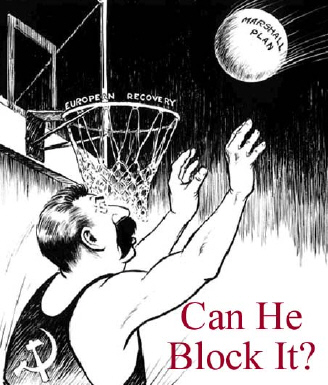 | The Soviet Union urges its communist
colleagues in Western Europe to take action against the Marshall Plan. In response, a series of strikes and demonstrations
sweep through Italy and France. Threats by the United States to withdraw Marshall Plan aid have an
impact, though, and the strikes eventually fail.
What does the cartoon on the left
mean??? | | |
Fears that
Italy's Communist Party would win the 1948 elections bring about a propaganda campaign in the
United States, as well as a campaign of covert operations from the newly formed CIA. Following the
Christian Democrats' victory in Italy, Washington unleashes a wave of aid, reviving the Italian economy. Meanwhile,
Yugoslavia under Marshal Tito breaks with Moscow after several years of uneasy alliance. Those
nations that remain behind the Iron Curtain would continue to live in subjugation until the late
1980’s.
|
|
|
62.
|
Why did the Communists want the
Marshall plan to fail?
a. | The Marshall Plan showed that the
West was concerned about the common people. | c. | The Marshall Plan made the Communists look
bad. | b. | The Marshall Plan helped to create “stability” in
Europe. | d. | All of these are reasons the Communists wanted the
Marshall plan to fail. |
|
|
|
63.
|
What did they call
organizations that supported the policies of the Soviet Union and worked to defeat the Western
democracies?
a. | Socialists | c. | Freedom Fronts | b. | Libertarians | d. | Communist Front Organizations |
|
|
|
64.
|
How did the United States react
to these new Communist organizations that worked against freedom in the West?
a. | formed the
FBI | c. | The U.S. did not
react | b. | formed the CIA | d. | Withdrew the Marshall Plan |
|
|
|
65.
|
When the people of Italy were
given a chance to vote for Communism or a Western Style free government in 1948. What did they
do?
a. | Voted to elect a Communist
Government | c. | Elected the
Christian Democrats | b. | Elected a Fascist style state | d. | Refused to vote at all. |
|
|
|
Three years after the end of World War II, the Nazis' former capital,
Berlin, would once again find itself the target of an allied air fleet. This time, the air armada was
working to save, rather than destroy, the city.
DIVIDED GERMANY
Following World War II, Germany is divided into four zones of occupation --
Soviet, British, French and American. Germany, and Berlin in particular, are the only places where
communist and Western forces come into direct contact. | 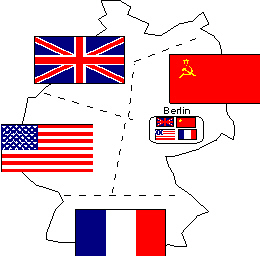 | | |
The city of Berlin is
inside the Soviet sector and it is also divided into four zones. Three and a half million Berliners
live deep inside Soviet lines. The Nazis' once-proud capital, reduced to a pile of rubble by
Allied anger, is down to its bare essentials. The people of Berlin are starving and the Soviets will
not allow the other nations to come into the city. To get to the city the other nations have to go
through the Soviet zone.
|
|
|
66.
|
How many zones was Germany
divided into after WWII?
|
|
|
67.
|
Which of the following
countries had zones in Germany
a. | British | d. | French | b. | American | e. | Each of these countries had a zone | c. | Soviet |
|
|
|
68.
|
The city of Berlin was also
divided into four zones. Where was the city of Berlin located?
a. | Inside the British
zone | c. | Inside the Soviet
zone | b. | Inside the American Zone | d. | Inside the French zone |
|
|
|
69.
|
Why was it a problem for the
city of Berlin to be inside the Soviet zone?
a. | The Western allies had to go through
the Soviet zone to get to Berlin | c. | Berlin was the former capital of Germany | b. | There were no good roads into
Berlin | d. | There were many Nazi’s living
there. |
|
|
|
70.
|
Why was Germany, and especially
Berlin, a very dangerous place for world peace in the late 1940’s?
a. | Stalin made a new non-aggression
pact with Germany | c. | The Soviets were
threatening to drop an atomic bomb on the city. | b. | The Nazi’s were still very powerful in Germany and
many Germans wanted a war with the Soviet Union and the Allies | d. | It was the only place where Western and Soviet troops were in direct contact
and any spark could set off a war. |
|
|
|
71.
|
What was the “allied
anger” that reduced the city of Berlin to a pile of rubble?
a. | Missile attacks by the Soviet
Union | c. | Bombing by Moslem
extremists | b. | French troops went on a rampage in Berlin after the
war | d. | Round the clock bombing by Britain and the
U.S. |
|
|
|
72.
|
Why did many Americans join the
Communist party in the 1930’s
a. | Being a Communist was an easy way to
become rich | c. | Communism taught
that all property should be privately owned. | b. | The Depression caused many to loose faith in the
Capitalist system | d. | Capitalism was against private
property |
|
|
|
73.
|
Communism
was
a. | an international
movement | c. | against the law in
the United States | b. | a movement only inside the Soviet Union and
China | d. | not attractive to college
students. |
|
|
|
74.
|
Which statement below is
not true?
a. | Some American Communists spied for
the Soviet Union | c. | Being a Communist
was “cool” on American college campuses in the
30’s | b. | The Great Depression made Communism attractive to many
Americans | d. | Though some Americans became
Communists they all remained loyal to the United
States. |
|
|
|
75.
|
The American, French and
British areas of Berlin were known as _____ Berlin, while the Soviet area of Berlin was known as
_____ Berlin.
a. | Eastern -
Western | c. | Communist -
Soviet | b. | Western - Eastern | d. | Communist - Capitalist |
|
|
|
76.
|
Life in East Berlin was an
example of the _____ of the communist system
a. | failure | c. | technology | b. | success | d. | power |
|
|
|
77.
|
Castro is a
_____
a. | Capitalist | c. | National Socialist | b. | Communist | d. | Libertarian |
|
|
|
78.
|
Why is Cuba important to the
United States and why was it a threat during the Cold War?
a. | Cuba has a large amount of natural
resources and wealth | c. | It is only 90
miles from the U.S. and a Communist client of the Soviet Union | b. | Cuba has an army that rivals the U.S. Army and is close
enough to attack the U.S. | d. | All of these are
true |
|
|
|
CURRENCY
REFORM
In June 1948, an
announcement by the Western Allies brings a crisis to Berlin. They establish a currency reform meant
to wipe out the German black market and further tie the vulnerable German economy to the West. The
Soviets are not told and are infuriated by the action. Moscow says Berlin is located in the Soviet
zone and therefore "economically forms part of it."
Sir Brian Robertson, the British
military governor in Berlin, along with his U.S. counterpart, Gen. Lucius Clay, respond by
introducing a special version of a new German currency, the deutschmark, stamped with a "B"
for Berlin.
|
|
|
79.
|
Why did the Western allies
introduce a new form of money (the deutschmark) into Germany?
a. | help to tie Germany to the West
instead of the Soviets | c. | control the Black
Market | b. | all of these reasons | d. | improve the economy of Germany |
|
|
|
80.
|
The Russians were did not want
the people of Berlin to use the new money because Berlin was in their sector. What did the allies do
to the money used in Berlin to pacify the Russians?
a. | Went back to the old money that
Germany was using. | c. | let the Russians
use Russian money instead of German money | b. | The allies did nothing to pacify the
Soviets | d. | stamped a B on the back of the
money |
|
|
|
AIRLIFT
On Thursday, June 24, 1948, West Berlin wakes to find itself under a Soviet blockade --
and in the midst of the first major confrontation of the Cold War. The Soviets block all of the roads
and railroads so the Allies can not get to the city. The people in Berlin are close to starvation and
there is no fuel to heat their homes. The Western Allies impose a counter-blockade on the Soviet
zone. The Soviets hope to starve the West out of Berlin.
President Truman was faced with a
problem. If the West tried to crash through the Soviet blockade it might set off a new war. If we do
nothing the city of Berlin will come under the domination of the Communists.
The West had been
through a similar short-term Soviet blockade of Berlin two months earlier -- and had responded with
an airlift using air corridors set up in a 1945 agreement with the Soviets. President Truman vows
that we will not be driven out of Berlin. New plans are drawn up -- for long-term replenishment of
West Berlin from the air. The Berlin Airlift has begun.
|
|
|
81.
|
How did the Soviets blockade
the city of Berlin?
a. | closed all air traffic to the
city | c. | sent tanks to attack the Western
Allies | b. | closed all roads and railroad traffic | d. | the Soviets did not blockade
Berlin |
|
|
|
82.
|
Why didn’t the Western
Allies just wait it out until the Soviets got tired of blocking traffic to the
city?
a. | the people of Berlin wanted to be
part of the Communist block | c. | the people of Berlin were starving and there was no fuel for
heating | b. | the Soviets were getting ready to attack with their superior tank
force. | d. | the Western Allies had no
patience |
|
|
|
83.
|
Who made the decision to send
supplies into Berlin by airplane?
a. | Winston
Churchill | c. | Joseph
Stalin | b. | The French | d. | Harry Truman |
|
|
|
84.
|
Why was President Truman
concerned about the Berlin blockade by the Soviet Union?
a. | The people of Berlin were
starving | c. | There was a chance
of a new World War with the Soviets | b. | The people of Berlin had no fuel | d. | Truman was concerned about all of
these. |
|
|
|
85.
|
When did the Berlin blockade
start
a. | June,
1948 | c. | July,
1945 | b. | June, 1949 | d. | August, 1946 |
|
|
|
NEW
ALLIES
The Berlin airlift
brings a new mindset to the Western Allies, who start thinking of West Germany as an ally, rather
than an occupied territory. In West Berlin, the airlift brings people sustenance and hope. In one
memorable instance, the airlift -- in the form of American pilot Gail Halvorsen -- rains candy on
West Berlin's desperate children.
As it becomes evident that the Soviets are not going to
back down from their blockade, the Western Allies consider how to expand their airlift operations.
Larger cargo planes are brought in, as well as bombers with cargo capacity
|
|
|
86.
|
What was the important new
attitude in the West caused by the Berlin blockade?
a. | The West started to think of Germany
as a new ally rather than an occupied country. | c. | The West got tired of helping the people of
Europe | b. | The West got tired of helping the German people
| d. | Americans wished they had just backed down when the
Soviets blocked Berlin |
|
|
|
87.
|
When the Soviets refuse to back
down from the blockade, what do the Americans do?
a. | Try to find a way out of the
situation | c. | Order bigger
planes to expand the airlift | b. | Give up and withdraw their troops | d. | Ask the French to take over the
airlift |
|
|
|
88.
|
What does the airlift bring to
the German people in Berlin?
a. | fear and
starvation | c. | anger and
resentment against the West | b. | food and optimism | d. | hatred of Americans |
|
|
|
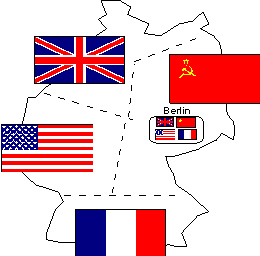 | WEST-EAST
Berliners are still free to move around their city,
despite the Soviet blockade. While West Berlin is suffering through shortages of electricity and
other essentials, the eastern sector offers a relatively normal lifestyle. Politically, however, the
city is on edge.
Soviet troops harass West Berliners who go to the eastern zone. And in
September, a communist attempt to take over the city council sparks mass protests -- which end in
violence. It is obvious that the people of West Berlin do not want to be part of the Soviet
Bloc | | |
|
|
|
89.
|
How is life in West Berlin
during the blockade?
a. | the same as life in East Berlin
(Russian Sector) | c. | Peaceful and
quiet | b. | Hard - little food, fuel or energy | d. | Happy - go - lucky |
|
|
|
90.
|
Why is Berlin on
edge,politically, during the blockade?
a. | The German political parties hate
each other. | c. | The Soviets are
trying to take over the city and make it part of the Communist bloc | b. | Germans do not like
politics | d. | The city is not on edge
politically |
|
|
|
91.
|
What is true about the people
of Berlin”
a. | They want to be part of the Soviet
bloc | c. | They do not like
Americans | b. | They want to be part of the Western bloc | d. | They fear Americans |
|
|
|
92.
|
How did the Soviet troops treat
the people of West Berlin?
a. | The troops harassed
them | c. | They ignored
them | b. | With kindness and understanding | d. | Soviet troops were not near the people of West
Berlin. |
|
|
|
93.
|
Look at the map above. The
Soviet flag is at the
a. | bottom of the
map | c. | middle left of the
map | b. | top left of the map | d. | top right of the map |
|
|
|
94.
|
Look at the map above. The
British flag is at the
a. | bottom of the
map | c. | top left of the
map | b. | top right of the map | d. | middle left of the map |
|
|
|
BLOCKADE
ENDS
The Soviet Union ends its
blockade of Berlin on May 12, 1949. A month earlier, at the airlift's peak, Western cargo planes
were landing at one of Berlin's three airports at a rate of one every 62 seconds. By the time
the airlift ended, more than 275,000 flights had carried 2.3 million tons of supplies to Berlin -- an
effort that went down in history as an aviation and logistical feat.
At least 79 people, including
31 Americans, 39 British and nine Germans, had lost their lives, mostly in plane crashes. But the
confrontation proved to be only the opening act in the decades-long Cold War.
|
|
|
95.
|
Was the Berlin Airlift
successful?
a. | yes | c. | Can’t tell from the
text. | b. | no |
|
|
|
96.
|
The Berlin
airlift
a. | marked the end of the Cold
War | c. | was not part of the Cold
War | b. | marked only at the beginning of the Cold War | d. | was caused by the Germans |
|
|
|
97.
|
The Berlin
airlift
a. | was a victory for the
Soviets | c. | was a victory for
the Americans | b. | was a defeat for the West | d. | was a defeat for West Berlin |
|
|
|
It was one of the few times the Cold War
went hot. The conflict on the Korean peninsula claimed millions of lives, and set the stage for the
way both sides would view each other for years to come.
A “cold war” is a war
without shooting.
A “hot war” is a war that involves shooting and killing.
The
Korean War devastated millions of lives, divided a people, involved troops from across the globe and
threatened to erupt into a Third World War.
The Soviet Union and Communist China supported and
encouraged the Communist North Koreans to invade South Korea in 1950. The U.S. and other Western
countries supported South Korea
| | | |
|
|
|
98.
|
The Korean War was
.....
a. | a hot
war | c. | a war between North Korea and
China | b. | a cold war | d. | a war between North Korea and
Russia |
|
|
|
99.
|
The _____ encouraged North
Korea to invade South Korea.
a. | Communist Chinese and South
Korea | c. | United
States | b. | Soviet Union and Communist China | d. | United Nations |
|
|
|
100.
|
In the Korean war, _____ was
the aggressor.
a. | the United
States | c. | South
Korea | b. | the United Nations | d. | North Korea |
|
|
|
INVASION
The surrender of Japan at the end of World War II also meant an end to 35 years of
Japanese occupation in Korea. As they had in Germany, Soviet and U.S. troops liberated Korea -- and
agreed to divide the nation along the 38th parallel into North and South Korea as a temporary
measure.
But as both sides withdrew their troops, they also set up rival governments, creating the
Communist People's Republic of Korea in the North, and the Republic of Korea in the
South.
|
|
|
101.
|
How long had Japan occupied
Korea before it was liberated by the United States and the Soviet Union after World War
II?
a. | 20
years | c. | 35
years | b. | 25 years | d. | 50 years |
|
|
|
102.
|
Where did the Soviet Union and
the United States divide Korea into North and South after World War II?
a. | Yalu
River | c. | 40th
parallel | b. | Chinese Border | d. | 38th parallel |
|
|
|
WAR
Stalin (the Soviet Dictator) also was heartened by the
communist victory in China in 1949 and believed it was time to open an Asian front to expand
Communism. On June 25, 1950, the North Korean army rolled south in a surprise assault.
In
the pre-dawn hours of June 25, 1950, North Korea sent an invasion force across the 38th parallel into
South Korea. The Northern forces rapidly advanced southward against the ill-equipped defenders,
taking the Southern capital Seoul three days after the invasion began. The United Nations condemned
North Korea's attack. The Soviet Union, was boycotting the U.N. Security Council at the time --
and was thus unable to veto the council's condemnation, which set up a U.N. force to help defend
South Korea.
The United States led the U.N. force in the so-called "police action"
against North Korea. But four U.S. divisions, rushed to the Korean peninsula to stop the Northern
attack, could do little against a superior force. The U.N. forces were soon forced back to a
perimeter around the southern port city of Pusan by early August. The U.N. and the U.S. troops were
trapped in Pusan. |  | | |
|
|
|
103.
|
Why did Stalin give his support
for an invasion of North Korea into South Korea.
a. | He wanted to defend Korea against
Communist China | c. | He wanted to
expand Capitalism in Korea | b. | Stalin did not support the invasion. | d. | He wanted to expand Communism into
Asia. |
|
|
|
104.
|
North Korea took the capital of
South Korea, _____ in three days.
a. | Pyongyang | c. | Korea | b. | Seoul | d. | Tokyo |
|
|
|
105.
|
Within a few weeks, the
Communist North Koreans had the United Nations and the United States forces trapped in the Port of
_____
a. | Pyongyang | c. | Pusan | b. | Seoul | d. | Yalu |
|
|
|
106.
|
Which statement below is
true?
a. | The Unites States wanted war with
North Korea | c. | The North Koreans
were not prepared for war with the South | b. | The United Nations forced the Russians out of the Security Council so they
could defend South Korea | d. | The United States and South Korea
were not prepared for war with the North. |
|
|
|
107.
|
Which of the following
countries was working with the United Nations to defeat the Communists in the Korean
War?
a. | United
States | c. | Soviet
Union | b. | Communist China | d. | North Korea |
|
|
|
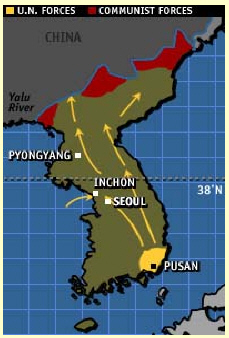 | U.N. ACTS
The United States took
advantage of a Soviet boycott of the United Nations to have the U.N. Security Council condemn North
Korean aggression -- and create a U.N. military force that would defend South Korea.
That U.N.
force included soldiers from 16 nations, with the largest contingent coming from the United States
--- all under the command of U.S. Gen. Douglas MacArthur. At first, the U.N. troops were helpless
against the North Korean assault -- and for a while appeared on the verge of being driven from the
peninsula. But General MacArthur devised a daring attack behind North Korean lines at the port of
Inchon and trapped the North Korean forces. The U.N. forces took back Seoul, the capital of
South Korea and drove the Communist North Koreans back to the Yalu river at the Chinese border.
General MacArthur was the hero of this offensive | | |
|
|
|
108.
|
Who was the leader of the
United Nations forces in Korea?
a. | General George
Marshall | c. | Sigmund
Rhee | b. | General Douglas MacArthur | d. | General George Patton |
|
|
|
109.
|
General MacArthur attacked the
North Koreans behind their front lines with a surprise troop landing at Inchon. What was the result
of this daring plan?
a. | The U.N. forces quit and the
Americans were left to fight the war themselves. | c. | The U.N. forces had to withdraw back to
Japan. | b. | The U.N. forces were defeated at Inchon and their troops were isolated at the
Port of Pusan | d. | Many North Korean troops were
captured and the U.N. forces pushed the Communists back to the Chinese border.
|
|
|
|
110.
|
The Security Council at the
United Nations is a group of the most important countries such as the U.S., the Soviet Union,
England, France, and others. Any one country on the Security Council can block the United Nations
from taking any action. Why didn’t the Soviet Union block the U.N. from taking action against
Communist North Korea?
a. | The Soviets did not like North
Korea | c. | The Soviets were boycotting the
Security Council so the U.N. authorized action while they were
absent. | b. | North Korea was not a Communist State | d. | The soviets were not part of the Security Council because they did not like
the U.N |
|
|
|
111.
|
What river acts as a natural
boundary and separates Korea from China?
a. | Mississippi | c. | Communist Pyongyang | b. | Yalu | d. | Inchon |
|
|
|
112.
|
How many United Nations were
working with the United States in the Korean war?
|
|
|
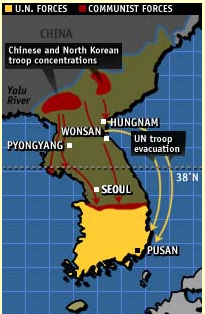 | CHINA
North Korea's neighbor,
the People's Republic of China, watched with alarm as U.N. forces drove the North Koreans out of
the South. MacArthur assured U.S. President Truman there was no possibility of China entering the
war. But unknown to Western leaders, 500,000 Chinese -- called the People's Volunteers -- were
preparing to enter Korea.
In November 1950, China attacked -- sending the surprised U.N. forces
reeling southward. The U.N. forces were trapped by the Communist Chinese. The U.N. forces fought
their way out of the trap and retreated South of Seoul. The Communist forces took control of the
South Korean capital, Seoul, for the second time.
| | |
|
|
|
113.
|
How many Chinese soldiers
joined the North Korean army to attack the U.N. forces?
a. | 100,000 | c. | 500,000 | b. | 200,000 | d. | 1,000,000 |
|
|
|
114.
|
Why was China alarmed at the
advance of the U.N. and U.S. to its border?
a. | China did not want Western, anti
Communist forces on its border. | c. | China did not want U.N. and Soviet forces on its
border | b. | China did not want Koreans on its border | d. | China wanted to control trading on the Yalu
river |
|
|
|
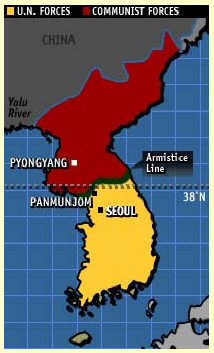 | STALEMATE
U.N. troops stopped the advance by North Korean and Chinese forces near the 38th
parallel -- and the war developed into a painful stalemate. MacArthur, had called for the bombing of
Chinese cities and pursuit of the North Korean and Chinese armies into China. He warned that the U.N.
forces had to destroy the North Korean and Chinese armies. He also wanted to get the Nationalist
Chinese forces in Formosa to help the U.N. forces. President Truman said that Korea was not a war but
a “Police Action” and he warned MacArthur to stop expressing his opinions in public.
MacArthur would not be quiet so President Truman fired him.
By the summer of 1951 armistice talks
began. It wasn't until July 1953, after months of pointless fighting and the death of Soviet
dictator Joseph Stalin, that a cease-fire was finally agreed to. Despite the armistice, the Korean
peninsula remains divided to this day -- and a potential global
flashpoint
| | |
|
|
|
115.
|
Why did President Truman fire
General Douglas MacArthur?
a. | The U.S. did not need a general
because the Korean war was really only a police action. | c. | The North Koreans and the Communist Chinese did not like MacArthur and Truman
wanted trade with the Communists. | b. | MacArthur would not obey the President and in the U.S. the civilian President
is always superior to the military officers. | d. | President Truman had a better plan for winning the Korean
War. |
|
|
|
116.
|
After years of fighting, where
was the armistice line finally drawn between North and South Korea?
a. | At the Yalu river on the Chinese
border. | c. | Right where the
war started, at the 38th parallel. | b. | South of Seoul | d. | North of Pyonyang |
|
|
|
117.
|
An armistice is an agreement to
stop fighting, it is not really a peace treaty and the nations are technically still at war.
Armistice talks between the North Koreans and the United Nations started in 1951. How long was it
before an armistice was finally signed.
a. | More than two
years | c. | We have a peace treaty in Korea but
no armistice | b. | Six months | d. | We still do not have an armistice in
Korea |
|
|
|
HOLLYWOOD
In the late 1940’s Americans could not understand
how they won World War II and seemed to be loosing all over the world to international communism. At
home, Americans feared communist subversion and spies. Congress revived the House Committee on
Un-American Activities to investigate Communism in the U.S. In 1947, the committee investigated
America's film industry. In the late 1940’s Ronald Reagan was head of the actors
union called the Screen Actors Guild. Reagan had to fight the communists who made an attempt to take
over the actors union. People were afraid that communists in Hollywood were using the movies to
promote Soviet Communism while undermining the United States. Some of Hollywood's best-known
actors, producers and writers were called to testify to the House Un-American Activities Committee
(HUAC).
| 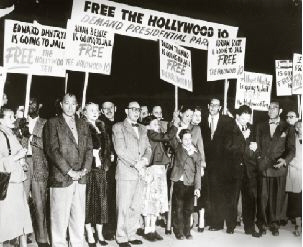 Most actors and producers cooperated with the committee but 10 witnesses, who became
known as the Hollywood Ten, defied the committee's line of questioning. The 10 were imprisoned.
Hundreds more in Hollywood, suspected of communist sympathies, were blacklisted by the movie
companies and unable to find work. Most actors and producers cooperated with the committee but 10 witnesses, who became
known as the Hollywood Ten, defied the committee's line of questioning. The 10 were imprisoned.
Hundreds more in Hollywood, suspected of communist sympathies, were blacklisted by the movie
companies and unable to find work. | | |
|
|
|
118.
|
What was the House Un-American
Activities Committee?
a. | a group set up by the communists to
promote anti-American activity | c. | an organization set up by the Hollywood movie houses to promote
anti-Americanism | b. | a committee set up by Congress to investigate communist influence and activity
in the United States | d. | a group set up by 10 people in
Hollywood to investigate communism |
|
|
|
119.
|
What famous person was head of
the Screen Actors Guild (actors union) in the late 1940’s and fought to keep the communists
from taking over the union.
a. | Ronald
Reagan | c. | Samuel
Goldwyn | b. | Alger Hiss | d. | Joseph McCarthy |
|
|
|
120.
|
When the House Un-American
Activities Committee called Hollywood people to testify, a group of witnesses refused to cooperate
with the committee so they were put in jail. What was the group called?
a. | Screen Actors
Guild | c. | The Hollywood
protestors | b. | Actors Union | d. | The Hollywood Ten |
|
|
|
121.
|
Why were some people afraid of
Communists in Hollywood?
a. | They thought the Soviet Union might
steal the movie industry from us. | c. | They thought that Hollywood Communists might undermine the United States by
making communist movies | b. | They thought that Hollywood Communists might give atomic secrets to the
Soviets | d. | People were not afraid of communists in
Hollywood |
|
|
|
122.
|
Why were Americans confused and
alarmed about Communism after World War Two?
a. | They were afraid that the U.S. might
have to go to war in Korea | c. | They could not understand how the U.S. won the war and seemed to be loosing to
Soviet Communism all over the world. | b. | They thought that the Nazi party might take control in Germany by signing an
agreement with the Soviet Union | d. | They though communism might promote illegal immigration from Canada and
Mexico |
|
|
|
WITCH HUNTS
In the United States there is strong disagreement between
Democrats and Republicans and Liberals and Conservatives over the investigation of Communism.
Democrats and Liberals usually refer to these investigations as “Witch Hunts” or
“The Red Scare.” Republicans and Conservatives believe the investigations were necessary
and proper.
Several U.S. politicians became famous through these investigations. A State
Department official, Alger Hiss, was accused by a former communist of passing secrets to the Soviet
Union. Leading the prosecution against Hiss was a young California congressman named Richard
Nixon who later went on to become Vice President and then President. Recent information from the
Soviet Unions secret archives proved that he was in fact a Soviet spy who worked in the U.S. State
Department and was a top advisor to Presidents Truman and Roosevelt.
Fear of communism also
brought Republican Sen. Joseph McCarthy into the limelight. McCarthy was asked by the Senate to
investigate communist influence in the U.S.Government. McCarthy was very close to John F. Kennedy and
Robert Kennedy served as an advisor to McCarthy
| 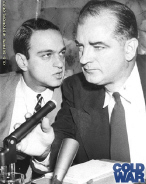
Roy Cohen and
Sen. Joe McCarthy
Roy Cohen
tried to use his influence to keep his lover from being sent to the war in Korea. When the Army would
not agree, he and McCarthy attacked the army. During Senate hearings, McCarthy claimed to have lists
of communists in the U.S. military, State Department and other government agencies. For months,
McCarthy was able to attack people's reputations at will. He and Cohen eventually fell out of
public favor and power -- after he denounced leading Republicans and senior Army officials as
communists
| | |
|
|
|
123.
|
How did Joseph McCarthy come to
lead the committee investigating communism in the U.S. Government?
a. | the Senate asked him to
investigate | c. | he was already a
member of HUAC | b. | the House of Representatives asked him | d. | his family had influence in
government |
|
|
|
124.
|
What groups did not agree with the investigations of communists
and called them “Witch Hunts” and “The Red Scare?”
a. | Republicans and
Liberals | c. | Democrats and
Liberals | b. | Rep[Republicans and Conservatives | d. | Democrats and Conservatives |
|
|
|
125.
|
What was the name of the Soviet
spy who worked in the U.S. State Department and advised Presidents Roosevelt and
Truman?
a. | Richard
Nixon | c. | Alger
Hiss | b. | Roy Cohen | d. | Joe McCarthy |
|
|
|
126.
|
What politician became famous
by prosecuting Alger Hiss and then went on to become Vice President under Eisenhower and later
president himself
a. | Roy
Cohen | c. | Robert
Kennedy | b. | Richard Nixon | d. | Joseph McCarthy |
|
|
|
127.
|
All of the following were
anti-Communist except
a. | Joseph
McCarthy | d. | Robert
Kennedy | b. | Richard Nixon | e. | Roy Cohen | c. | Alger Hiss |
|
|
|
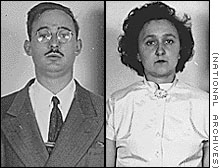 Julius and Ethel
Rosenberg Julius and Ethel
Rosenberg
Electrocuted for Treason
| ROSENBERGS
The fate of Julius and Ethel Rosenberg came to symbolize
the excesses of the U.S. Red Scare. The couple were convicted of passing atomic secrets to the Soviet
Union and sentenced to death. Liberals were convinced that they were innocent, Conservatives were
convinced that they were guilty. Recent revelations by the Soviet KGB have proven that they were in
fact Soviet spies who gave atomic bomb secrets to the Soviet Union
Despite protests that the death
sentence against the Rosenbergs -- who had young children -- was unconstitutional, they became the
first U.S. civilians to be executed in peacetime for espionage.
| | |
|
|
|
128.
|
What crime was the Rosenbergs
convicted of ?
a. | refusing to testify to the
Senate | c. | perjury | b. | stealing money from the State Department | d. | passing atomic secrets to the
Soviets |
|
|
|
129.
|
Recent evidence supplied by the
Soviet KGB has proven that the Rosenbergs were _____
a. | guilty | c. | only partly guilty | b. | innocent | d. | persecuted by the Soviet Union |
|
|
|
STALIN
In 1952, an old but still-unchallenged Stalin presided
over the 19th Congress of the Soviet Communist Party. Before a hall packed with international
dignitaries, Stalin declared that capitalists were losing the global class struggle and international
communism would soon control the world
But at home, Stalin saw treachery everywhere. Most of all,
he suspected so-called cosmopolitans, mostly Jewish intellectuals and professionals. In January 1953,
nine Kremlin doctors -- five of whom were Jewish -- were accused of plotting with Western
intelligence to kill Soviet leaders. The affair inflamed Russian anti-Semitism.
Weeks later,
Stalin collapsed of a brain hemorrhage. No one dared treat him as he lay half-conscious on the floor.
Stalin died on March 5, 1953. Even those in the Soviet bloc who hated him could not imagine a future
without him.
| Stalin sent
millions of people to death camps called Gulags and had many people executed. Some claim that he
killed as many or more people than Adolf Hitler.
| | |
|
|
|
130.
|
What Soviet leader declared
that Capitalism was dead and soon communism would take over the world?
a. | Joseph
McCarthy | c. | Lenin | b. | Joseph Stalin | d. | Khrushchev |
|
|
|
131.
|
When Stalin claimed that
communism would triumph over capitalism, what country was he suggesting would loose the Cold
War?
a. | Korea | c. | China | b. | Yugoslavia | d. | United States |
|
|
|
132.
|
In what way was Stalin and
Hitler the same?
a. | they both attacked
Jews | c. | they were both
atheists | b. | they were both Christians | d. | they were both of German
ancestry |
|
|
|
133.
|
Hitler was to the concentration
camps as Stalin was to _____
a. | the
Jews | c. | the
Communists | b. | the Gulags | d. | Capitalism |
|
|
|
134.
|
What is
anti-Semitism?
a. | hatred of the
Nazi’s | c. | hatred of
Communism | b. | hatred of Capitalism | d. | hatred of the Jews |
|
|
|
The Soviet atomic bomb gives
started an arms race between the U.S. and the Soviets. Who was going to have the most powerful
military? After the Soviets were the first to put a satellite into space a space race between the
“Super Powers” started.Now the U.S. and the Soviets had thousands of missiles pointed at
each other. Any promising technological advances are overshadowed by the threat of long-range nuclear
destruction.
DUCK &
COVER
In August 1949, the
United States finds itself shocked to discover the Soviet Union has broken Washington's atomic
monopoly. The new Soviet bomb was developed quickly, thanks to the acquisition of U.S. atomic secrets
by Soviet agents. The bomb also signals the start of the nuclear arms race between the Cold War
rivals.
By 1952, the United States develops and tests the first hydrogen bomb. The Soviets match
that milestone several years later. Meanwhile, American children watch as bomb shelters are dug in
their backyards and learn in school to "duck and cover" should nuclear bombs fall in their
neighborhoods

|
|
|
135.
|
The arms race was
...
a. | a competition between the U.S. and
Russia to see who had the best boxers | c. | a race to see who would have the best
scientists. | b. | a race between the U.S. and the Soviets to see who had the superior
military | d. | a race to see who would be superior
in space, U.S. or the Soviets |
|
|
|
136.
|
Why did American children
practice “duck and cover” in school during the 1950’s
a. | Americans were worried about natural
disasters like earthquakes | c. | Americans were worried about Soviet nuclear
attacks | b. | It had been a part of the fire safety program in schools for
years | d. | This was a way that the government had to frighten the
population so they would okay more money for defense. |
|
|
|
137.
|
What was the Washington
monopoly that the Soviets broke?
a. | a spy ring in the U.S. State
Department | c. | civil defense
procedures like, “duck and cover. | b. | the U.S. was the only nation to have atomic weapons in the early
50’s | d. | American military codes that enabled
Russia to listen to our secrets |
|
|
|
SPUTNIK
In 1952, Dwight Eisenhower was elected to succeed Harry Truman as U.S.
president. Less than a year later, Soviet dictator Joseph Stalin was dead, starting a power struggle
among the Kremlin leadership. In 1955, Eisenhower met with a Soviet delegation in Geneva and proposed
an "Open Skies" policy -- giving both sides the freedom to fly over each other's
territory and observe for themselves military developments on the ground. Nikita Khrushchev, then
emerging as top Soviet leader, announced his delegation's refusal.
Soviet engineers,
meanwhile, had been busy developing missile technology. They tested the world's first
intercontinental ballistic missile in May 1957. And on October 4 of that year they surprised the
world by launching Sputnik -- the world's first satellite.
|
|
|
138.
|
President Eisenhower proposed
to the Soviets that both sides be allowed to fly over the other sides territory so neither side would
have to worry about a surprise attack. What was the policy called?.
a. | Open Sky
Policy | c. | Eisenhower
Doctrine | b. | Truman Doctrine | d. | Cold War Policy |
|
|
|
139.
|
What did intercontinental
ballistic missiles allow the Soviets to do?
a. | Knock down any incoming American
missiles | c. | The Soviets could
attack Europe but not the U.S. | b. | Improve their domestic economy | d. | The Soviets could now hit the U.S. with atomic
weapons |
|
|
|
140.
|
Which statement below is
False?
a. | In the early 50’s the Soviets
seemed to be ahead of the U.S. in space technology | c. | The Soviets were the first to put a satellite in
space | b. | The U.S. was not concerned about Soviet scientific advances because we had a
superior military. | d. | The Soviets were the first to launch
develop an intercontinental missile |
|
|
|
141.
|
After the death of Stalin in
1953, who was emerging as the new Soviet leader?
a. | Joseph
Stalin | c. | No one, because of the power
struggle | b. | V.I. Lenin | d. | Nikita Kruschev |
|
|
|
CATCH-UP
Sputnik came as a shock to the West and especially the United States, which
realized the Soviets now had the ability to send not only satellites around the world, but nuclear
weapons as well. The U.S. military tried to push forward with its own satellite, called Vanguard, but
the first attempt to launch Vanguard was a spectacular failure. Eventually, with the help of German
scientist Werner von Braun, the Explorer satellite was fired into space on top of a military Redstone
missile.
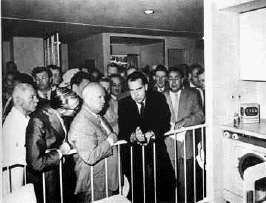
Krushchev and Nixon in the Kitchen
Debate | In 1959, Khrushchev became the first Soviet leader to visit the United States.
While he and Eisenhower spent part of the visit discussing ways to slow the arms race,
Khrushchev's visit is best remembered for his ideological sparring with then-U.S. Vice President
Richard Nixon. Krushchev and Nixon argued about the superiority of the Soviet or U.S. political
system. In this debate Krushchev made the famous statement, “We will bury
you.” | | |
|
|
|
142.
|
Early attempts by the U.S. to
catch up to the Russians in missile technology were
a. | successful because of
Vanguard | c. | a
failure | b. | showed our superiority in technology | d. | showed that the Soviets had the atomic bomb but no way to deliver it to the
U.S. |
|
|
|
143.
|
In 1959, _____ was president of
the United States and _____ was vice president.
a. | Eisenhower -
Nixon | c. | Khrushchev -
Eisenhower | b. | Nixon - Eisenhower | d. | Eisenhower - Von Braun |
|
|
|
144.
|
What did Eisenhower and
Krushchev discuss on his visit to the U.S. in 1959?
a. | Ways to slow the technology
developments | c. | The division of
Germany | b. | Ways to slow the arms race | d. | Ways to use German scientists to slow the arms
race |
|
|
|
145.
|
In his visit to the U.S. in
1959, Krushchev demonstrated
a. | that the Soviet System was
inferior | c. | fear of another
nuclear war with the U.S. | b. | confidence in the superiority of Soviet
Technology | d. | fear of superior American
technology |
|
|
|
146.
|
Soviet rockets are to Sputnik
as Redstone is to _____
a. | Khrushchev | c. | Sputnik | b. | Von Braun | d. | Explorer |
|
|
|

Francis Gary Powers and the U-2 spy plane | U-2
Eisenhower was concerned about how big the "missile gap" was between the
United States and Soviet Union. U.S. reconnaissance planes, designated U-2s, secretly flew over the
U.S.S.R., looking for evidence of missiles. On one such mission, a U-2 was shot down by the Soviet
military.
Despite U.S. denials, the Soviets presented as evidence the plane's wreckage -- as
well as its pilot, Francis Gary Powers, who had survived the shoot-down. Khrushchev and Eisenhower
were scheduled to meet in Paris for a Summit meeting to talk about ways to ease Cold War tensions.
The U-2 incident undermined a Paris summit several weeks later between Khrushchev and Eisenhower and
Khrushchev refused to go. Powers was sentenced to prison but was later exchanged for a Soviet
spy | | |
|
|
|
147.
|
Why did the U.S. send U-2
planes over the Soviet Union
a. | to learn about Soviet
missiles. | c. | to promote
peace | b. | to promote goodwill | d. | to prepare for a U.S. attack on the Soviet
Union |
|
|
|
148.
|
What is a summit
meeting?
a. | A meeting at the United
Nations | c. | A meeting between
leaders at Summit, Switzerland | b. | A meeting between the heads of states to discuss some
issue | d. | A meeting between members of
Congress |
|
|
|
149.
|
What was
U-2?
a. | A rock music
group | c. | A Russian Spy
plane | b. | A united summit between 2 people | d. | An American Spy plane |
|
|
|
150.
|
How did the Russians treat
Francis Gary Powers after he was shot down?
a. | Tried him as a spy and put him in
prison | c. | Released him to ease tensions
between the U.S. and the Soviet Union | b. | Tried him as a spy and executed him | d. | Exiled him to Russian Siberia |
|
|
|
151.
|
Eisenhower was to the United
States as Khrushchev was to
________
a. | the space
program | c. | the Soviet
Union | b. | the U-2 spy plane | d. | Francis Gary Powers |
|
|
|
DISASTER/TRIUMPH
At the time, the United States thought the Soviet Union was far ahead in
rocket and space technology. In fact, it was later learned that the Soviets were not so far ahead as thought.
Khrushchev feared the American U-2 flights had exposed his claims of missile superiority as a bluff.
At the Baikonur Cosmodrome, engineers under the command of Marshal Nedelin were ordered to create a
new missile. During the rush to production, a fire erupted -- killing nearly 200 people.
While
the Soviets were behind in the missile race, they still had one card to play: Yuri Gagarin. On
April 12, 1961, Gagarin achieved international acclaim when he became the first human to be
launched into space.
|
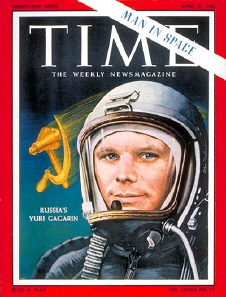 | | |
|
|
|
152.
|
What country was first to put a
man in space?
a. | United
States | c. | Soviet
Union | b. | Germany | d. | Great Britain |
|
|
|
153.
|
In 1960 which country was ahead
in missile and space technology?
a. | Soviet
Union | c. | Germany | b. | United States | d. | No one was ahead |
|
|
|
154.
|
How did the U.S. learn that the
Soviets were having problems with their space program?
a. | pictures of the Soviet Union taken
from the U-2 spy planes | c. | Time magazine
reports that Yuri Gagarin died along with 200 people at a Soviet space disaster
| b. | the spy work of Alger
Hiss | d. | The Soviets were not having problems with their space
program |
|
|
|
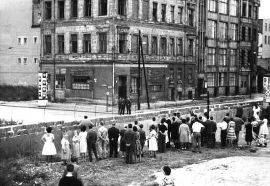 | For years, West Berlin was an escape route for East Germans seeking to flee
communism. But growing Cold War tensions forced the Soviet bloc to erect a deadly blockade across the
city -- a Wall that divided Berlin for nearly three decades.
| | |
|
|
|
155.
|
How long did the Berlin Wall
stay in place?
a. | 300
years | c. | 30
years | b. | 30 months | d. | 3 years |
|
|
|
156.
|
Who used the wall as an escape
route?
a. | Soviets trying to escape to East
Germany | c. | East Germans
trying to escape to the Soviet Sector | b. | West Germans trying to escape to the Eastern
Sector | d. | East Germans fleeing to the
West |
|
|
|
BERLIN
After World War II the Soviets kept their vast armies and even increased their numbers.
They were a powerful military machine. In order to defend against Soviet aggression, the Western
countries joined together and formed a joint military force called, “NATO.” By 1958, West
Germany was NATO's front line along the Iron Curtain.
Berlin, meanwhile, was creating a
different kind of nightmare for the Soviet bloc. The city was still under the joint occupation of
France, Britain, the U.S.S.R. and the United States -- an arrangement that began when the four powers
were wartime allies. Berliners could move freely between the city's Eastern and Western sectors,
allowing the East Germans to see how well the West Germans were living..
West Berlin was
considered a danger to the existence of East Germany. Nikita Khrushchev proposed Berlin become a
"free city," with its own foreign policy. But the West rejected Khrushchev's idea
because they realized that Khrushchev really wanted to control the entire city of
Berlin..
|
|
|
157.
|
The Western allies joined
together to form a military organization to defend against Soviet aggression. This army was called
_____
a. | WEST
SETO | c. | NATO | b. | THE MACHINE | d. | EAST NATO |
|
|
|
158.
|
Why did the Soviet bloc
not want the Berliners
moving back and forth between the East and West sectors?
a. | they did not want the West Berliners
to see how good the East Berliners were living. | c. | they did not want the East Berliners to see how good the West Berliners were
living. | b. | they did not want the East Berliners to become
communist | d. | they did not care if Berliners moved
back and forth |
|
|
|
KHRUSHCHEV
Khrushchev issued a new demand, calling on the Western
powers to withdraw from Berlin or the Soviet bloc might take military action to throw the West out.
Ensuing talks between the West and the U.S.S.R. got nowhere. But the talks persuaded Khrushchev to
put aside his Berlin ultimatum. In September 1959, he became the first Soviet leader to visit
the United States, where he met with President Eisenhower.
A second Eisenhower-Khrushchev summit
collapsed before it had even begun -- following the shoot-down of an American U-2 spy plane, which
had been flying over Soviet airspace
| | | |
|
|
|
159.
|
What did Khrushchev want the
West to do about Berlin?
a. | get out | c. | share power | b. | stay | d. | bring NATO in |
|
|
|
160.
|
Who was President of the United
States in 1959
a. | Franklin
Roosevelt | c. | Truman | b. | John F. Kennedy | d. | Eisenhower |
|
|
|
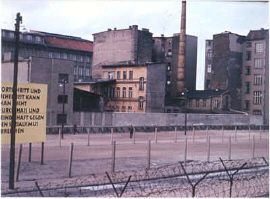 | EAST GERMANY
By the end of the 1950s, East Germany portrayed itself as a socialist paradise. But the
reality was far different. Dependence on heavy industry created shortages of essential goods and
consumer items. East Germany knew it could not compete with the swelling prosperity of West Germany.
Every month, thousands of East Germans fled across the open Berlin border and took refuge in the
West. Most of the refugees were young and skilled. Their departure was bleeding the East German
economy to death. East German leader Walter Ulbricht urged Khrushchev to recognize East Germany as a
sovereign state.
| | |
|
|
|
161.
|
By the end of the 1950’s
_____ Germany was prosperous, in contrast to _____ Germany
a. | East -
Soviet | c. | Soviet -
East | b. | West - East | d. | West - American Sector |
|
|
|
162.
|
How did the escape of East
Germans into West Germany through Berlin hurt the East German economy?
a. | Many of the people escaping were
German spies. | c. | Most of the people
escaping were young people with skills that East Germany needed for its
economy. | b. | Most of the people escaping were young people with educations that West
Germany needed for its economy | d. | Most of the people escaping were unskilled labor that the East needed for
manual labor. |
|
|
|
163.
|
East German leader Walter
Ulbricht urged Khrushchev to recognize East Germany as a sovereign state. What does this tell you
about the relationship of East Germany to the Soviet Union?
a. | the Soviets were dictators over East
Germany | c. | the Soviets were
inferior to the East Germans | b. | the East Germans were afraid of the West | d. | West Germany was inferior to East
Germany |
|
|
|
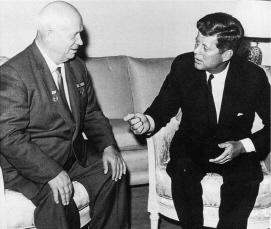
Khrushchev and Kennedy at the Vienna Summit in 1961

German Refugees Trying to Escape Communism | THE
WALL
John F. Kennedy became
U.S. president in January 1961. He agreed to meet Khrushchev and other world leaders in June of
that year. The other world leaders at the Summit were “Giants” of world history and had
led their countries through World War II. Kennedy was young and inexperienced and the other
leaders did not respect him. Shortly before the summit in Vienna, Kennedy attempted to invade
Castro's Cuba, at the Bay of Pigs, and failed miserably. Khrushchev attempted to bully Kennedy
at the summit, warning him that Soviet bloc forces could invade West Berlin at any time.
By that
time, the flow of refugees from East to West Berlin had become a torrent. East German officials
begged Moscow to let them stem the flow. On the morning of August 13, 1961, East German and Soviet
troops sealed the East Berlin side of the border, closing crossing points and erecting barricades.
The Berlin wall was erected and Berlin was divided.
| | |
|
|
|
164.
|
Why did Khrushchev believe that
he could bully and threaten President Kennedy?
a. | Kennedy was also a
dictator | c. | Kennedy was
perceived to be tough because he tried to invade Cuba | b. | Khrushchev was mentally
unbalanced | d. | Kennedy was inexperienced in world
affairs |
|
|
|
165.
|
Most experts agree that
Khrushchev would never have agreed to build a wall between East and West Berlin if Eisenhower were
still in office. Why did Khrushchev think he could erect a wall with Kennedy in
office?
a. | Kennedy was busy in Korea and
Cuba | c. | The experts were
wrong | b. | Khrushchev thought Kennedy would not respond to Soviet
aggression | d. | Kennedy also wanted a
wall |
|
|
|
166.
|
Khrushchev was to Kennedy as a
teacher is to _____
a. | a misbehaving
student | c. | the principal of a
school | b. | the parent of a student | d. | the police |
|
|
|
167.
|
The flow of refugees from East
to West Berlin showed that ...
a. | there were too many people in East
Berlin | c. | Communism was a
failure | b. | there were too many people in West Berlin | d. | Communism was a success |
|
|
|
DIVIDED
Angry West Berliners demonstrated against the division of
their city, a divide that separated many families. The allies were unsure how to react -- their
rights within Berlin had not been challenged by the Soviets. But a border crossing confrontation
prompted U.S. Gen. Lucius Clay to bring up tanks. The Soviets responded with their own show of force.
Both sides later withdrew their armor.
Many in the East, meanwhile, risked death to flee across
the Wall. Within the first year, 50 Germans died trying to cross to the West. One of them,
18-year-old Peter Fechter, bled to death in the no-man's land between East and West, in front of
outraged West Berliners.
In 1963, Kennedy visited West Berlin -- telling its residents that all
free people were citizens of Berlin and "therefore as a free man, I take pride in the words,
'Ich bin ein Berliner.'"
Yet for the next three decades, the Wall remained a
symbol of the Cold War's cruelty and Europe's division. Its message was a bitter one:
Whatever happened beyond that line, the West might lament, but would not
interfere.
| 
Demonstrations
against the Berlin Wall
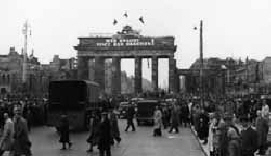 | | |
|
|
|
168.
|
How did Germans react to the
building of a wall that divided the city
a. | with fear of the East Berlin
government | c. | with anger and
protestations | b. | with fear of the West Berlin government | d. | with anger at the weak American
President |
|
|
|
169.
|
How did the Allied Powers react
to the erection of the Berlin wall?
a. | They were not sure what to
do | c. | Calling a special session of
Congress | b. | They were sure and resolute | d. | They threatened to declare war on the Soviet
Union |
|
|
|
170.
|
By finally accepting the Berlin
wall, the West was really saying that ...
a. | it was most likely a good thing to
have a wall between East and West Berlin | c. | it would not interfere in the affairs of West
Germany | b. | the Berlin Airlift was a failure | d. | it would not interfere with the affairs of East Germany and the Soviet
occupation |
|
|
|
171.
|
When President Kennedy told the
people of Berlin, 'Ich bin ein Berliner,” he was showing ___ for the Soviet Union and
_____ with the people of Berlin
a. | joy -
anger | c. | contempt -
unity | b. | fear - unity | d. | dislike - frustration |
|
|
|
172.
|
How did the people of Berlin
react to President Kennedy’s speech?
a. | hatred and contempt for the
President | c. | anger at President
Kennedy | b. | joy and affection for President Kennedy | d. | fear of the Soviet Union |
|
|
|
NATIONALIZATION
The United States government and President Eisenhower was now aware that
Castro was a Communist and was transforming Cuba into a Soviet satellite. Castro's new
government nationalized millions of acres of Cuban land previously held by American companies and
distributed it to the people. Castro flew to New York to speak at the United Nations. U.S. President
Eisenhower would not meet with him. But Soviet leader Khrushchev was delighted to embrace a new
revolutionary and offered Cuba economic assistance because he felt that Cuba, 90 miles from the U.S.
could be useful in the Cold War.
Cuba decided to purchase oil from the U.S.S.R., but U.S.
companies refused to refine it. Castro then nationalized the U.S.-owned refineries and other
industries in Cuba. Washington retaliated with a complete trade embargo against Cuba. (A trade
embargo means that a country will not buy or sell anything from another country.) It also launched
the first of several CIA campaigns to topple Castro's regime. | |
|
|
|
173.
|
Why did Khrushchev embrace
Castro?
a. | Khrushchev thought Cuba could be
useful to the Soviets in the Cold War | c. | Relations between the U.S. and Cuba were
strained | b. | Castro was a fellow communist | d. | All of these |
|
|
|
174.
|
From the reading you can see
that the U.S. took many aggressive steps against Cuba after Castro took power. Why did America act
with such hostility?
a. | America had a long history of
hostility against the Cuban people. | c. | The U.S. was jealous of Cuba because it was friendly with the
Soviets. | b. | Cuba had become a strategic partner of the Soviets in the global Cold War and
a potential threat to the U.S.. | d. | It was the policy of the U.S. government to topple all Central
American governments because a destabilized Central America was in the U.S. best
interest. |
|
|
|
175.
|
What was the embargo imposed
against Cuba by the U.S.?
a. | Cuba refused to buy from or sell
anything to the U.S. | c. | Cuba refused to
trade with the U.S. | b. | The U.S. refused to buy from or sell anything to
Cuba. | d. | The U.S. refused to trade with the Soviet Union but would
trade with Cuba |
|
|
|
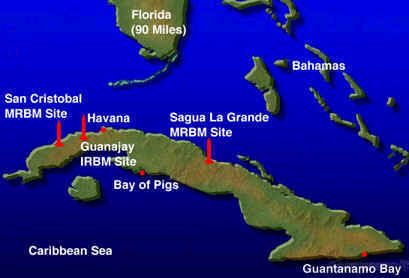 |  Kennedy sees Castro and Cuba as a threat to the United States so he authorizes
the invasion of Cuba anti-Castro Cubans. Kennedy sees Castro and Cuba as a threat to the United States so he authorizes
the invasion of Cuba anti-Castro Cubans.
The feud between the two men becomes personal and
assassination attempts were made. | BAY OF
PIGS
A plan to overthrow Castro
was presented to the new U.S. president, John F. Kennedy, soon after his inauguration in 1961. CIA
agents had been secretly training Cuban exiles (anti-Castro Cubans) to invade their homeland. They
thought the Cuban people would welcome such an invasion and rise up to overthrow Castro. Kennedy
agreed to the invasion plan -- but demanded crucial changes to hide U.S. involvement.
On April
15, 1961, six U.S. bombers disguised as Cuban aircraft took off from Nicaragua and attacked Cuban
airfields -- but caused only minimal damage. The next day, a CIA-trained force of 1,500 guerrillas
arrived at the Bay of Pigs, 125 miles south of Havana. But their plans soon turned into disaster.
Kennedy, now faced with international condemnation for the bombing, canceled additional air
support for the invasion. Castro's remaining air force quickly destroyed ships carrying vital
ammunition supplies for the invaders. Without American air support or supply, the invasion force was
quickly outnumbered and outmaneuvered. All of the invaders were captured or dead within 72 hours.
| | |
|
|
|
176.
|
Who was President of the U.S.
during the Cuban Bay of Pigs invasion. He approved the invasion.
a. | Dwight
Eisenhower | c. | Lyndon
Johnson | b. | John Kennedy | d. | Harry Truman |
|
|
|
177.
|
Why did the Bay of Pigs
invasion fail?
a. | the U.S. did not provide air support
for the anti-Castro forces, as promised | d. | only a and c are correct | b. | the people did not revolt against Castro as
expected | e. | a, b, and c are
correct | c. | the invaders were short of supplies and
ammunition. |
|
|
|
178.
|
The people who did the fighting
at the Bay of Pigs were Cuban exiles. What is a Cuban exile?
a. | A Cuban, loyal to
Castro | c. | An anti-Castro Cuban living in
Cuba | b. | A Cuban who is pro-Castro but anti-U.S. | d. | An anti-Castro Cuban who left Cuba after Castro took
power. |
|
|
|
179.
|
The Bay of Pigs invasion made
President Kennedy look _____ and Fidel Castro look _____ .
a. | weak -
strong | c. | strong -
strong | b. | strong - weak | d. | weak - weak |
|
|
|
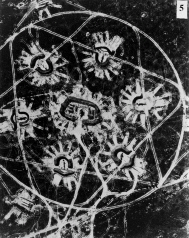
U2 Photograph
showing Soviet Missile sites in Cuba |
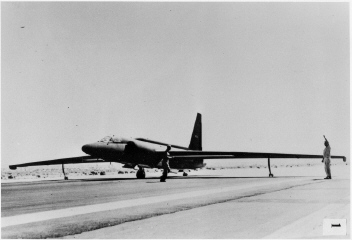 U2 Spy
plane U2 Spy
plane
Took photographs that warned the U.S.
| MISSILE CRISIS
The failure of the Bay of Pigs invasion did not keep the United States from
plotting new plans to get rid of Castro -- even assassination was carefully weighed. Cuba, meanwhile,
looked to Moscow for military support.
President Kennedy had allowed the Soviets to build the
Berlin Wall so Nikita Khrushchev did not respect Kennedy. Khrushchev offered to deploy Soviet
nuclear missiles in Cuba .and after initial resistance, Castro accepted the missiles. By July 1962,
the CIA had noticed an increase in Soviet ships heading for Cuba. By mid-October, U-2 spy planes
flying over Cuba brought back pictures of ballistic missile sites.
With nuclear warheads less
than 100 miles from the United States, the Soviets had the ability to strike any U.S. city without
warning. Kennedy formed a special inner cabinet of advisers -- the Executive Committee of the
National Security Council, or ExCom -- to weigh the options. Under consideration: a military invasion
to topple Castro and "surgical air strikes" against the missiles bases. But taking either
step without warning risked turning world opinion against the United States.
Another solution was
devised: The U.S. Navy would stop and search all ships heading for Cuba. Washington called it a
"quarantine." The Kennedy administration did not know how the Soviets would react if
Americans tried to stop and search Soviet ships. It could mean war.
| | |
|
|
|
180.
|
Why were Soviet missiles in
Cuba a threat to the U.S.
a. | The missiles in Cuba could strike
almost any city in the United States | c. | The missiles were not a threat because the U.S. could trust
Cuba | b. | If one of the missiles blew up by mistake it could destroy
Florida | d. | The missiles were not a threat because the U.S. could
trust the Soviets |
|
|
|
181.
|
How did the U.S. know the
Soviets were building offensive missile sites in Cuba?
a. | Castro bragged about the sites to
the world press | c. | The U.S. was
conducting U2 flights over Cuba | b. | Khrushchev told the U.S. as a warning | d. | Cuban spies were reporting the sites to the
CIA |
|
|
|
182.
|
What made the Soviets think
they could build offensive missile sites 90 miles from Florida without United States
interference?
a. | They knew Kennedy was afraid of
Khrushchev | c. | The U.S. did not
interfere when the Soviets built the Berlin Wall. | b. | The Soviets thought the United states would not learn
about the missiles | d. | The Soviets thought the United
Nations would approve |
|
|
|
183.
|
Kennedy formed a small group of
his most trusted advisors to help him solve the problem. The options they considered were
a. | invasion, negotiation,
Quarantine | c. | Quarantine,
suicide invasion, boycott | b. | invasion, air strikes, Quarantine | d. | attack on Russia, air strikes,
nothing |
|
|
|
AT THE BRINK
On October 22, President Kennedy told the world about the
discovery of Soviet missiles in Cuba and announced that a blockade was in force against all ships
bound for Cuba. Kennedy demanded the removal of the missiles from Cuba.
For several days the
world held its breath as the United States and Soviet Union appeared to be moving toward nuclear war.
Washington took its case to the United Nations and prepared for air strikes and a massive invasion of
Cuba.
Havana announced a "combat alarm" -- more than a quarter-million Cubans stood
ready to repel a U.S. invasion. Soviet forces on the island were equipped with nuclear-tipped
tactical missiles, ready to answer any invader.
In the United States, a wave of panic buying
swept across the country as people tried to prepare for a possible nuclear holocaust. And though
Soviet leaders tried to keep the crisis from their people, the news was leaking out, raising fears.
During and after the crisis many people had bomb shelters built in their yards and basements.
The
U.S. and the Soviets were headed for a show down. Soviet ships were heading for Cuba and Kennedy said
he would not let them through. If they tried to run the blockade there would be war. The world held
its breath.
|
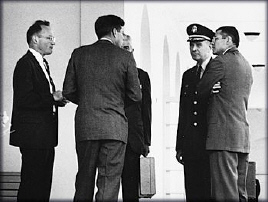
Kennedy Advisors -
What to do?
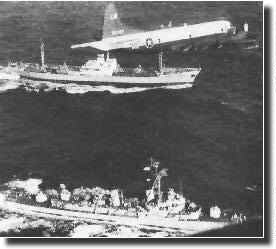 U.S. Planes Track Soviet Ships U.S. Planes Track Soviet Ships
If they try to run
the U.S. naval blockade there will be war between the Soviets and the
U.S. | | |
|
|
|
184.
|
Unlike his attitude toward the
Soviets for building the Berlin Wall, Kennedy’s attitude about he Cuban Missile Crisis was
a. | thoughtless | c. | soft | b. | unconcerned | d. | firm |
|
|
|
185.
|
The greatest danger of the
Cuban Missile was
a. | Loss of trade between the U.S. and
Cuba | c. | Communism might spread to the
U.S. | b. | Russia might invade Cuba | d. | Nuclear war might break out between the U.S, and the Soviet
Union |
|
|
|
186.
|
If you offer a carrot to a
horse (reward) and threaten him with a stick (punishment) at the same time it is called “carrot
and stick.” treatment. When you apply this idea to nations it is called “carrot and stick
diplomacy.” Who used “Carrot and Stick Diplomacy” in the Cuban Missile
Crisis?
a. | The Soviet
Union | c. | The United
States | b. | The Cuban government | d. | none of these |
|
|
|
187.
|
Which nations were ready for
war in the Cuban Missile Crisis?
a. | The U.S., Soviets and
Cuba | c. | The Soviets and
Cuba | b. | The U.S. and Soviets | d. | The Cubans and the U.S. |
|
|
|
188.
|
How did the American
people react to the Cuban Missile Crisis?
a. | Wild panic resulting in looting and
hysteria in both countries. | c. | Americans were not worried. | b. | Mild panic as people worried and stocked up on food and
water. | d. | Americans decided they would rather be Red than Dead.
(surrender to communism) |
|
|
|
| A WAY OUT
On October 26, with tensions increasing, Kennedy received
an offer from Khrushchev. The Soviet leader offered to withdraw his missiles from Cuba -- if the
United States promised never to invade the island. The next morning, Khrushchev added another
condition: the United States was to remove all its missiles from Turkey.
As Kennedy considered
the options, the crisis escalated again -- when a Soviet-led Cuban missile battery shot down a U-2
spy plane. The Pentagon was prepared to bomb the missile site, as contingency plans required -- but
Kennedy ordered that no action be taken. He wanted time to deal with Khrushchev.
The president
sent his brother, Attorney General Robert Kennedy, to meet with Soviet Ambassador Anatoly Dobrynin.
They struck a deal: Soviet missiles would be removed from Cuba in return for the unpublicized removal
of missiles from Turkey. On Sunday October 28, Khrushchev announced the withdrawal of the Soviet
missiles from Cuba. Under close American surveillance, Soviet ships took the missiles back home.
The crisis was over, but both sides were well aware how close they had come to nuclear
annihilation.
| |
|
|
|
189.
|
Khrushchev agreed to remove
Soviet missiles from Cuba if the U.S. .....
a. | removed its missiles from
Turkey | c. | promised not to invade
Turkey | b. | promised not to invade Cuba | d. | promised not to invade Cuba and removed its missiles from
Turkey |
|
|
|
190.
|
President Kennedy may have
seemed weak at the beginning of the Cuban Missile Crisis but by its end he showed that he was
a. | decisive | c. | strong | b. | diplomatic | d. | all of these |
|
|
|
191.
|
How many nuclear weapons were
used during the Cuban Missile Crisis?
|